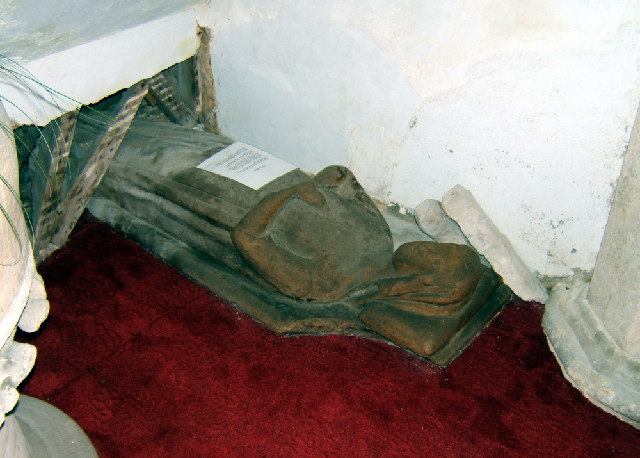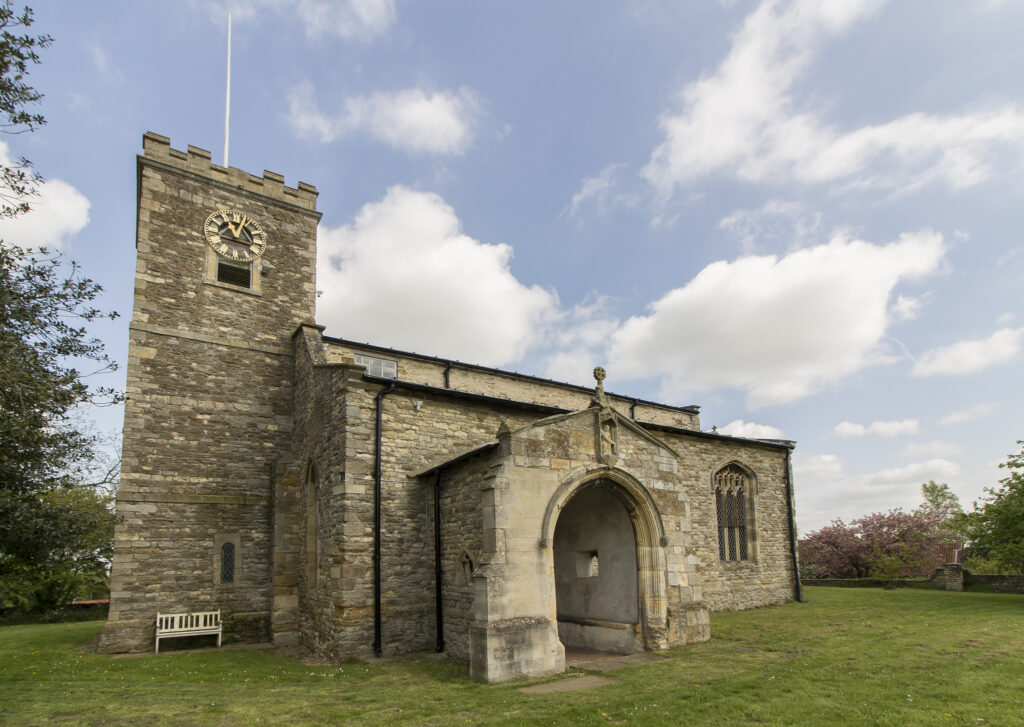Every Good Friday, at Glentham, Lincolnshire, a strange custom took place known as ‘Washing Molly Grime’. Seven poor spinsters from the parish would fetch water from a spring called Newell Well and carry it in procession for two miles back to the village. They would then wash a figure on a tombstone inside Glentham Church, known locally as Molly Grime.

It is unclear when this bizarre tradition began, but it was financed by a rent from a local estate, which was probably left as a bequest in a will. The bequest granted seven shillings annually to pay the seven spinsters for their work.The tradition lapsed in 1832, when the estate the money came from was sold and no provision was made for the bequest to continue.
The strangeness of the Molly Grime custom has long left people puzzled. This confusion is expressed in a nursery rhyme, recorded by Farjeon in 1957:
Seven old maids,
Once upon a time,
Came of Good Friday,
To wash Molly Grime,
The water for washing,
Was fetched from Newell,
And who Molly was
I never heard tell.Seven old maids,
Got when they came,
Seven new shillings,
In charity’s name,
God bless the water,
God bless the rhyme,
And God bless the old maids,
Who washed Molly Grime.
To understand the origin of the Molly Grime tradition, we must delve into England’s Catholic past. The washing of holy effigies is a Catholic practice, which has particular resonance around Easter as this imitates the washing of Christ’s corpse after his crucifixion.
Winn, in the journal Notes and Queries (1888-9), wrote:
The church of Glentham was originally dedicated to Our Lady of Sorrows, a circumstance obviously alluded to by a sculpture in stone of the Virgin supporting the dead Christ in her arms, still to be seen over the porch entrance and placed there by some early representative of the Tourneys of Caenby, who had a mortuary chapel on the north side of Glentham Church.
The washing of the effigy of the dead Christ every Good Friday and strewing of his byer with spring flowers previous to a mock entombment, was a special observance here. It was allowed to be done by virgins only, as many as desired to take part in the ceremony being permitted to do so in mourning garb.
The custom being known as Molly Grime’s washing led to an erroneous idea that the rent charged was instituted by a spinster of that name, but Molly Grime is clearly a corruption of ‘Malgraen’ (which means) holy image washing (in) an ancient local dialect.

The idea that ‘Molly Grime’ herself could have left the money for her image to be washed may have resulted from a confusion of two separate practices. The image known as ‘Molly Grime’ is probably an effigy from the grave of Lady Anne Tourney, a noblewoman from a family of local landowners. Rudkin (1936) wrote:
“They’d wash a stone coffin top as in the church; this ’ere coffin top is in the form of a woman. ‘Molly Grimes’ they calls it.”
It is likely that there were originally two customs. One was the Catholic Easter practice of ‘Malgraen’ – the washing of an image of Christ. The other custom may have been instituted by the Tourney family – the annual washing of Lady Anne’s effigy.
When the Protestant Reformation (c.1517-1650) arrived in England, reformers tried to stamp out ‘superstitious’ Catholic practices like the veneration of holy images. While the washing of Christ’s image was probably suppressed, the washing of Lady Anne’s statue, being the result of a private bequest, may have been allowed to go on. As the years passed, memories of the two customs may have merged. The forbidden practice of ‘Malgraen’ became associated with the washing of Lady Anne’s tombstone and Lady Anne herself was transformed into ‘Molly Grime’. The figure of Molly Grime is now kept under the organ loft. It is thought to have been moved from the tombstone because of decay.
We might also ask why the water was brought from two miles away when there must have been water sources closer to hand. There is evidence that the water of Newell Well was believed to have healing and magical properties, which could explain why it was chosen for the Molly Grime ceremony. One legend, for instance, claimed that locals who drank from the well would never move away from Glentham.
A correspondent of Sutton (1997) stated:
An old boy told me about the healing well of Glentham. Some folks called it Newell’s Well. Many people came to take the waters and in the spring of the year, the church held an annual service for ‘good water for the rest of the year’; the service marked a new year for the waters. The well was dressed in a traditional way using clay and flower petals to make a kind of picture, usually of a saint. I’m told it looked very impressive.
The dressing and veneration of holy wells – often associated with saints – was a common practice in Catholic Britain, a practice which is often said to have had pre-Christian roots. Also, the waters of Newell’s Well run through seven courses of stone, which may have associated it with the importance of the number seven in the Molly Grime ritual.
Though the origins of Washing Molly Grime can be found in the traditions and upheavals of the Christian religion, there are aspects of the custom that speak of universal motifs found worldwide in mythology, mysticism, religion and folklore. There’s the idea of water as a cleansing, purifying force and – as the custom takes place at Easter – the idea of the season of spring as a fresh new start. The number seven is also prominent – with the seven spinsters and seven shillings – and the virginity of the participants is emphasised. Virgin goddesses feature in many mythologies and some ancient sanctuaries such as those in Rome were staffed by virgin priestesses.
Though the Washing of Molly Grime ended in 1832, a similar custom was practised in Glentham on Father’s Day between 2001 and 2007. In this version of the ritual, women ran to Newell Well then raced back to the village clutching water-filled balloons while trying not to burst them. It will be interesting to see if the Molly Grime custom manages to transform and reassert itself in future ages.
To sum up, the Molly Grime tradition can be seen as an interesting example of the interweaving of two separate folk practices until they reach the point where one custom is indistinguishable from the other. It can also be seen as an example of a tradition with identifiable Christian roots which nonetheless echoes common folkloric customs.
References & Further Reading
‘A Lost Lincolnshire Holy Well Tradition, the washing of Molly Grime‘ (2012) In Search of Holy Wells and Healing Springs (Website) [Date accessed 30/04/2018]
‘Custom Demised: the washing of Molly Grime’ (2012), Traditional Customs and Ceremonies (Website) [Date accessed 30/04/2018]
Glentham’s Past (2018) Lincolnshire Parish Councils (Website) [Accessed on 30/04/2018]
Roud S. (2006) The English Year: a month-by-month guide to the nation’s customs and festivals, from May Day to Mischief Night, Penguin Books
Rudkin E.H. (1936) Lincolnshire Folklore, EP Publishing

